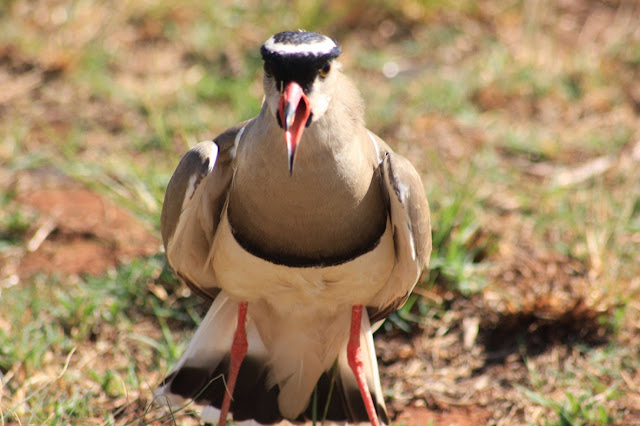Crowned plovers - Vanellus coronatus
After the big to-do of the Crowned Plover stopping my husband's 5-ton truck from destroying her nest, I kept on checking on their nest, from a distance, and Saturday morning at 8.30am I was rewarded by seeing two of the three eggs hatch, hopefully the third will follow soon. Luckily it was warm and sunny and the parents were keeping a close eye on the proceedings.
Trying to take these pics of them was an ordeal in itself, as I once again was dive-bombed mercilessly and one of them even almost got tangled up in my hair!
They are so well camouflaged, I almost missed them
Breeding occurs in the spring months from July to October. The nest is in a shallow depression in the soil with a lining of vegetation and other debris. There are normally 3 eggs, sometimes 2 or 4. Incubation requires 28 to 32 days and is done by both sexes. Immediately after hatching, the young leave the nest while both parents look after them. Egg-laying is timed to precede the rainy season and most incubating is done by the female. The male assists only on hot days, when he either incubates or shades the nest.
The one on the right is still wet, with some egg shell sticking to its feathers
Pretending no-one can see it!
Eyes tightly shut...
Bare-part colours of males brighten in the breeding season. Different types of display flights lure the female to the defended territory. A female accepting the male and territory will follow the male during his display flight. Mates may be retained for life.
Still wet from hatching out the egg
Although generally outnumbered by Blacksmith Lapwings, they are the most widespread and locally the most numerous lapwing species in their area of distribution. Their numbers have increased in the latter part of the 20th-century after benefiting from a range of human activities. They live up to 20 years.
After the photographic session, I left them in peace and 3 o'clock that afternoon I returned to find that the two hatchlings had moved about 3 meters away from the nest, hiding close to a clump of grass.
Their colours are absolutely gorgeous and perfectly suited to their surrounds. They both kept their eyes tightly shut, barely breathing as they tried to blend into the surrounds.
Those typical long legs are already apparent!
The third egg seems to have been abandoned. I returned early evening but couldn't find the babies anywhere. The parents were about 100meters further down the plot and I presumed the babies were there with them. I am totally thrilled to have witnessed this happening and now just hope and pray the next door neighbour's dogs keep away from my property!
::









































